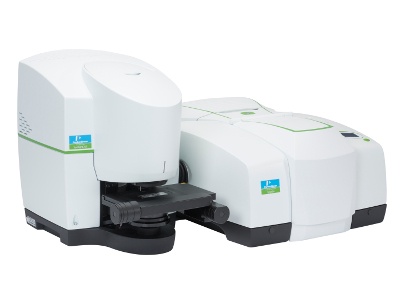
UV Vis Spectrometer
Ultraviolet–visible spectroscopy or ultraviolet-visible spectrophotometry (UV-Vis or UV/Vis) refers to absorption spectroscopy or reflectance spectroscopy in the ultraviolet-visible spectral region. This means it uses light in the visible and adjacent (near-UV and near-infrared [NIR]) ranges.The absorption or reflectance in the visible range directly affects the perceived color of the chemicals involved. In this region of the electromagnetic spectrum, atoms and molecules undergo electronic transitions. Absorption spectroscopy is complementary to fluorescence spectroscopy, in that fluorescence deals with transitions from the excited state to the ground state, while absorption measures transitions from the ground state to the excited state.
Designed in accordance with the governing Japanese and European Pharmacopoeia, the new UV-1800 UV-VIS spectrophotometer achieves a resolution of 1 nm, the highest in its class, in a compact design.
Offering an array of user-friendly features, the UV-1800 can be used either as a stand-alone instrument or as a PC-controlled instrument.
High resolution – 1 nm
Featuring the highest resolution in its class, the UV-1800 easily satisfies the standards of wavelength resolution demanded by the European Pharmacopoeia. Additionally, using a spectroscope with a Czerny-Turner mounting results in a compact, bright optical system. Stray light, wavelength repeatability and baseline stability have also been advanced to meet user requirements.
Ideal for use in regulated industries and when a wide range of sampling options and large number of samples are required, these spectrophotometers deliver trustworthy results with a minimum of operator training.
- Double-beam operation
- Excellent stability
- Consistent performance throughout lifespan
- Easy to use
- Simple replacement of prealigned halogen lamps
True double-beam operation provides the best possible stability and allows references to be measured and corrected in real time. Sealed and quartz-coated high-throughput optics ensure consistent performance throughout the meter’s service life. Very low stray light provides a wide dynamic range. Prealigned deuterium and tungsten halogen lamps allow easy replacement with no service call or downtime. Dual diode detector. Single monochromator.
Model 25 is a fixed-bandwidth system and is ideal for most routine UV/Vis applications and regulatory tests. It features a 1nm SBW configuration and meets all pharmacopeia requirements. Cell changers allow for high volume sampling and cell holders are Peltier controlled. For very high volume sampling, a sipper and autosampler are available.

UV Visible Lambda 25

Fourier Transform Infrared with Microscope
Fourier transform infrared spectroscopy (FTIR) is a technique which is used to obtain an infrared spectrum of absorption or emission of a solid, liquid or gas. An FTIR spectrometer simultaneously collects high spectral resolution data over a wide spectral range. This confers a significant advantage over a dispersive spectrometer which measures intensity over a narrow range of wavelengths at a time.
Spotlight 200i FTIR Microscope System is a high-performance microscopy platform, designed to generate high-quality, reproducible data from a variety of sample types.
The combination of the highly-automated, very easy-to-use system and exceptional sensitivity ensures that quality spectra can be obtained from sample areas down to the diffraction limit of 10 microns.
- Highest performance signal-to-noise system giving best quality spectra and fastest imaging
- Can operate in transmission, reflectance and automated micro-ATR for maximum sampling flexibility
- Can be used with extended range mid-IR, near-IR or dual range FT-IR configurations to give maximum information from samples in the shortest possible time
- Flexible, high-performance instrument allows exceptional applications capability
- Can be upgraded to a Spotlight 400 Imaging System allowing even faster imaging and the opportunity to add ATR imaging